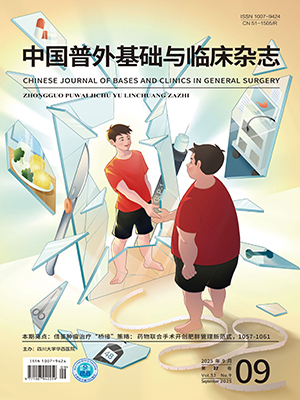| 1. |
Ma S, Chan KW, Hu L, et al. Identification and characterization of tumorigenic liver cancer stem/progenitor cells. Gastroenterology, 2007, 132(7): 2542-2556.
|
| 2. |
Govaere O, Roskams T. Pathogenesis and prognosis of hepatocellular carcinoma at the cellular and molecular levels. Clin Liver Dis, 2015, 19(2): 261-276.
|
| 3. |
Marquardt JU, Thorgeirsson SS. Stem cells in hepatocarcinogenesis: evidence from genomic data. Semin Liver Dis, 2010, 30(1): 26-34.
|
| 4. |
Kim H, Choi GH, Na DC, et al. Human hepatocellular carcinomas with “Stemness”-related marker expression: keratin 19 expression and a poor prognosis. Hepatology, 2011, 54(5): 1707-1717.
|
| 5. |
Chan AW, Tong JH, Chan SL, et al. Expression of stemness markers (CD133 and EpCAM) in prognostication of hepatocellular carcinoma. Histopathology, 2014, 64(7): 935-950.
|
| 6. |
Yamamoto N, Okano K, Kushida Y, et al. Clinicopathology of recurrent hepatocellular carcinomas after radiofrequency ablation treated with salvage surgery. Hepatol Res, 2014, 44(11): 1062-1071.
|
| 7. |
Heidenreich B, Rachakonda PS, Hemminki K, et al. TERT promoter mutations in cancer development. Curr Opin Genet Dev, 2014, 24: 30-37.
|
| 8. |
Rachakonda PS, Hosen I, de Verdier PJ, et al. TERT promoter mutations in bladder cancer affect patient survival and disease recurrence through modification by a common polymorphism. Proc Natl Acad Sci U S A, 2013, 110(43): 17426-17431.
|
| 9. |
Borah S, Xi L, Zaug AJ, et al. Cancer. TERT promoter mutations and telomerase reactivation in urothelial cancer. Science, 2015, 347(6225): 1006-1010.
|
| 10. |
Chen YL, Jeng YM, Chang CN, et al. TERT promoter mutation in resectable hepatocellular carcinomas: a strong association with hepatitis C infection and absence of hepatitis B infection. Int J Surg, 2014, 12(7): 659-665.
|
| 11. |
Kim H, Yoo JE, Cho JY, et al. Telomere length, TERT and shelterin complex proteins in hepatocellular carcinomas expressing “stemness”-related markers. J Hepatol, 2013, 59(4): 746-752.
|
| 12. |
Lo RC, Leung CO, Chok KS, et al. Variation of stemness markers expression in tumor nodules from synchronous multi-focal hepatocellular carcinoma - an immunohistochemical study. Diagn Pathol, 2017, 12(1): 56.
|
| 13. |
Kim H, Park YN. Hepatocellular carcinomas expressing ‘stemness’-related markers: clinicopathological characteristics. Dig Dis, 2014, 32(6): 778-785.
|
| 14. |
Yamashita T, Forgues M, Wang W, et al. EpCAM and alpha-fetoprotein expression defines novel prognostic subtypes of hepatocellular carcinoma. Cancer Res, 2008, 68(5): 1451-1461.
|
| 15. |
Govaere O, Komuta M, Berkers J, et al. Keratin 19: a key role player in the invasion of human hepatocellular carcinomas. Gut, 2014, 63(4): 674-685.
|
| 16. |
Tsujikawa H, Masugi Y, Yamazaki K, et al. Immunohistochemical molecular analysis indicates hepatocellular carcinoma subgroups that reflect tumor aggressiveness. Hum Pathol, 2016, 50: 24-33.
|
| 17. |
Durnez A, Verslype C, Nevens F, et al. The clinicopathological and prognostic relevance of cytokeratin 7 and 19 expression in hepatocellular carcinoma. A possible progenitor cell origin. Histopathology, 2006, 49(2): 138-151.
|
| 18. |
邢龙彬, 高英堂. 肝癌干细胞表面标志物研究进展. 世界华人消化杂志, 2016, 24(31): 4231-4237.
|
| 19. |
Zhao X, Parpart S, Takai A, et al. Integrative genomics identifies YY1AP1 as an oncogenic driver in EpCAM(+) AFP(+) hepatocellular carcinoma. Oncogene, 2015, 34(39): 5095-5104.
|
| 20. |
Seino S, Tsuchiya A, Watanabe Y, et al. Clinical outcome of hepatocellular carcinoma can be predicted by the expression of hepatic progenitor cell markers and serum tumour markers. Oncotarget, 2018, 9(31): 21844-21860.
|
| 21. |
Gurzu S, Kobori L, Fodor D, et al. Epithelial mesenchymal and endothelial mesenchymal transitions in hepatocellular carcinoma: a review. Biomed Res Int, 2019, 2019: 2962580.
|
| 22. |
Aizarani N, Saviano A, Sagar, et al. A human liver cell atlas reveals heterogeneity and epithelial progenitors. Nature, 2019, 572(7768): 199-204.
|
| 23. |
Zhou L, Zhu Y. The EpCAM overexpression is associated with clinicopathological significance and prognosis in hepatocellular carcinoma patients: a systematic review and meta-analysis. Int J Surg, 2018, 56: 274-280.
|
| 24. |
Lei J, Yan L, Wang W. Donor safety in living donor liver transplantation: a single-center analysis of 300 cases. PLoS One, 2013, 8(4): e61769.
|




